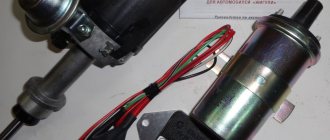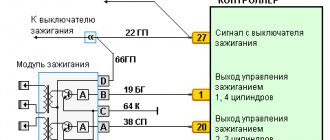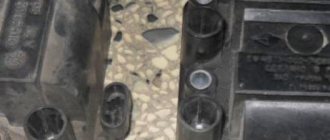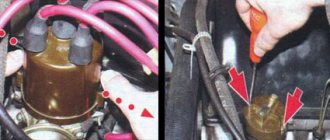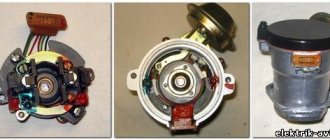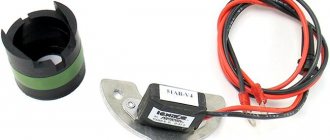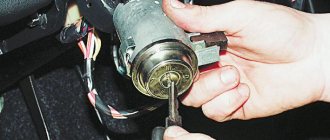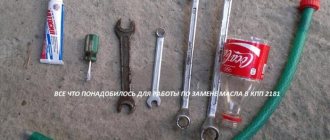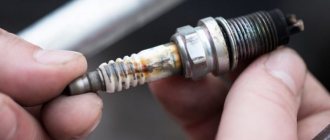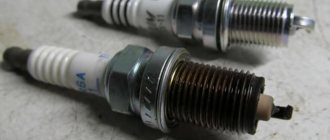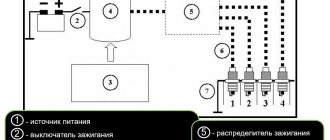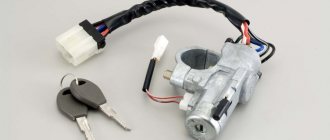As you know, an engine requires two conditions to operate: a combustible mixture and a spark. The exception is diesel engines. In them, ignition occurs due to high air compression. However, in cars with a gasoline engine, of which the majority are on the road, the ignition coil often fails. Signs of a malfunction may vary. Well, let's pay closer attention to this mechanism.
Signs of a faulty ignition coil
- Unstable engine operation. Popularly this is called tripling. This word appeared back in the days of the USSR, when one of the cylinders on the Soviet “classics” did not work. And as you know, all VAZ engines had four cylinders. Accordingly, the phenomenon when one of them does not work is called tripling. In this case, characteristic vibrations may occur. The motorist will also hear uneven operation of the engine - as if something is missing. This is understandable, because one of the cylinders is idling, that is, the combustible mixture in it does not ignite.
- “Tripling” motor. If one or more cylinders in the engine do not work, acceleration failures are possible. The car will twitch and vibrate. The car also picks up speed very slowly.
- Yellow lamp "Check Engine". Warning lights on the instrument panel may well be a sign of a faulty ignition coil. It is worth noting that this error is not necessarily related to this malfunction. The lamp only indicates general problems with the engine. If “Check Engine” lights up on the instrument panel, this means that a failure has occurred in some system. The car is subject to thorough diagnostics.
- High fuel consumption. Since one cylinder is not working, the remaining three (or more depending on the engine design) take on the entire load. Accordingly, in order to resume the previous power, the motor will require more energy. Fuel consumption can increase by 10 to 50 percent.
- Difficulty starting the engine. If there is a malfunction with the coil, the driver may experience problems of this kind. Moreover, they occur both when the engine is cold and when the engine is warm. Difficulty starting the engine is especially common in wet weather.
Also note that if the car does not start at all, this is not a sign of a coil failure. The fact is that there are several of them in the engine. Usually each cylinder has its own coil. On older ones, voltage is generated on two cylinders at once. Therefore, the motor will work until the last minute. If the car does not start at all, all the coils could fail at once. However, this is unlikely. In this case, experts recommend checking the fuses in the unit and the corresponding relays. Why does this happen? The reasons for coil failure will be discussed below.
Replacing ignition coils and spark plugs on LADA cars
According to the technical maintenance regulations for LADA cars, spark plugs are changed every 30,000 km. Depending on the engine, replacing the spark plugs will require removing high-voltage wires or individual ignition coils (ICO). Let's look at this process in detail.
On cars Lada Vesta, XRAY, Largus, Priora, Granta, Kalina, Lada 4×4) all actions are performed in the same way.
Insulation breakdown
Just like with candles, a breakdown in the insulation can occur here. What could be causing this? Often a breakdown occurs due to oil leaks that form at the junction of the valve cover, head and other elements. As the rpm increases, the oil pressure increases. Oil begins to get on all elements, including the ignition coil. Signs of malfunction: failures in acceleration, jerking and high fuel consumption. To prevent this, keep the engine compartment clean.
Please note that an insulation breakdown may also occur due to engine washing. Excess moisture gets onto the contacts, causing a short circuit. To prevent this, you should cover not only the battery, but also the coil itself. It is also recommended to insulate the distributor cap if it is an older car. By the way, a wet distributor is the most popular reason why a car won’t start at all. Sometimes you can limit yourself to drying contacts. But in 80 percent of cases, only replacement saves.
Other Lada Vesta
Products from the Dustershop77 range on the topic of the article:
| Name | Manufacturer | Price | Availability | Add to cart |
| DC060 | Filter mesh for the cabin air intake (with shagreen) | 900 / 700 rub. Discount: 500 rub. | >10 | |
| intro iso ant-1 | Antenna adapter Intro iso ant-1 | INTRO | 500 / 350 rub. Discount: 300 rub. | 2 |
| DC307-ASAM.30587 | Silent bolt (silent lock) ASAM 30587 | ASAM | 700 / 500 rub. Discount: 350 rub. | >10 |
| OBD-BT01 | Bluetooth OBDII - adapter for diagnostics | China | 1500 / 1000 rub. Discount: 900 rub. | >10 |
| DC1167 | Large shock absorber support cup cover | Analogue | 1000 / 700 rub. Discount: 500 rub. | 5 |
| multi-vc731 | On-board computer Multitronics vc731 | Multitronics | 8500 / 7500 rub. Discount: 6700 rub. | 2 |
| multi-c590 | On-board computer Multitronics C590 | Multitronics | 6900 / 5900 rub. Discount: 5490 rub. | 2 |
| DC909 | Oil filter cup puller | Analogue | 500 / 400 rub. Discount: 300 rub. | 2 |
| DC303 | 8mm L-shaped key for Renault oil plug | 200 / 150 rub. Discount: 100 rub. | 1 | |
| multi-cl590 | On-board computer Multitronics CL590 (without voice synthesizer) | Multitronics | 5900 / 5500 rub. Discount: 4990 rub. | 1 |
| multi-vc730 | On-board computer Multitronics vc730 | Multitronics | 7500 / 6500 rub. Discount: 5500 rub. | 2 |
| DC304 | Adapter key for Renault oil plug, 4 sides 8mm, 4 sides 13mm | 400 / 300 rub. Discount: 250 rub. | 7 | |
| DC314 | Case for glasses (eyeglass case) with bracket and parts for installation (original) | Original | 2300 / 1900 rub. Discount: 1500 rub. | 1 |
| DC452-07445 | External antenna Renault Duster ASAM 07445 analogue 7700773864 | ASAM | 500 / 300 rub. Discount: 250 rub. | 1 |
| DC691-LA6-V003 | Anti-theft protection for the electronic unit for Duster 2020, Largus, Logan 2, Sandero 2, Vesta, Xray, Arkana | 4900 / 3900 rub. Discount: 3400 rub. | 7 | |
| PU-4TC-BLACK | Multitronics PU-4TC parking sensors for on-board computers (sensor color: black) | Multitronics | 3500 / 3200 rub. Discount: 2850 rub. | 2 |
| DC1250 | Set of small fuses (10 pcs) | Analogue | 200 / 150 rub. Discount: 100 rub. | 4 |
| DC689 | Anti-theft protection with lock for OBD2 connector | 5000 / 4000 rub. Discount: 3500 rub. | 2 | |
| DC456-8200684863 | Antenna base 8200684863 original | Original | 1200 / 900 rub. Discount: 600 rub. | 1 |
| DC494-8200826850 | Case for glasses (eyeglass case) without bracket original 8200826850 | Original | 1200 / 900 rub. Discount: 700 rub. | 2 |
| DC190 | Monitor for rear view camera, foldable | China | 2500 / 2000 rub. Discount: 1700 rub. | 2 |
| DC533-7703072424 | Rivet for fastening the bumper bracket D=4.8mm (price for 1 piece) original art. 7703072424 | Original | 300 / 250 rub. Discount: 200 rub. | 7 |
| DC313-8200741954 | Renault ceiling handrail original | Original | 1900 / 1300 rub. Discount: 1200 rub. | 1 |
| DC455-200910477R | Exhaust pipe attachment (muffler) (diameter 50mm) 200910477R original | Original | 3500 / 2900 rub. Discount: 2400 rub. | 1 |
| DC1164-243454838R | Battery positive terminal cover original 243454838R | Original | 800 / 600 rub. Discount: 450 rub. | 3 |
| DC954-8200719629 | Manifold absolute pressure sensor MAP sensor for 2.0 and 1.6 engines - F4R/K4M original 8200719629 | Original | 2500 / 1900 rub. Discount: 1700 rub. | 2 |
| DC1195 | Fuse set 180pcs in a plastic box | China | 1000 / 700 rub. Discount: 600 rub. | 1 |
| DC305 | Nameplate sign Renault emblem original art. 908894785R | Original | 3000 / 2500 rub. Discount: 2300 rub. | 1 |
| DC438-32006 | Windshield washer pump gasket ASAM-SA 32006 (analogue 289215361R) | ASAM | 300 / 200 rub. Discount: 150 rub. | 7 |
| DC948-7700424981 | Sun visor holder original 7700424981 | Original | 500 / 350 rub. Discount: 300 rub. | 8 |
| DC1166 | Shock absorber support cup cover, small | Original | 700 / 500 rub. Discount: 350 rub. | 2 |
| DC485-497612479R | Power steering fluid pressure sensor original Renault 497612479R | Original | 1800 / 1400 rub. Discount: 1200 rub. | 1 |
| DC1610 | Large red shock absorber support cup cover (Sport) | Analogue | 350 / 200 rub. Discount: 100 rub. | 8 |
| DC1466-30539 | Fuel tank cap with lock | ASAM | 800 / 600 rub. Discount: 500 rub. | 5 |
| DC990-8200060049 | Seat heating switch original 8200060049 | Original | 800 / 700 rub. Discount: 600 rub. | 1 |
| DC1143 | Renault mirror control button (joystick) | Original | 700 / 500 rub. Discount: 450 rub. | 5 |
| PU-4TC-GRAY | Multitronics PU-4TC parking sensors for on-board computers (sensor color: gray) | Multitronics | 3500 / 3200 rub. Discount: 2800 rub. | 2 |
| DC1163 | Sun visor (sun protection) with mirror, right | Original | 1500 / 1300 rub. Discount: 1100 rub. | 8 |
| DC997-255678753R | Steering column switch right article number 255678753R | Original | 2800 / 2700 rub. Discount: 2700 rub. | 1 |
| DC1404 | Trunk lid and door lock activator (Asam/MANOVER analogue 7700712901) | Analogue | 1400 / 900 rub. Discount: 700 rub. | 1 |
| DC454-200910184R | Exhaust pipe attachment (muffler) (diameter 45mm) 200910184R original | Original | 3500 / 2800 rub. Discount: 2300 rub. | 1 |
| DC1144-7700413867 | Renault interior mirror original 7700413867 | Original | 2400 / 2200 rub. Discount: 1500 rub. | 1 |
| DC634-601986892R | Speed sensor (plug) for cars with ABS original 601986892R | Original | 1900 / 1650 rub. Discount: 1450 rub. | 1 |
| DC996-255675128R | Steering column switch left article number 255675128R | Original | 4700 / 4300 rub. Discount: 3800 rub. | 2 |
| DC1027-8201167988 | Left steering column switch with PTF article number 8201167988 / 255400337R | Original | 6000 / 4700 rub. Discount: 4000 rub. | 1 |
| 35026 | Repair book for VAZ LADA Xray | 1700 / 1500 rub. Discount: 1300 rub. | 1 | |
| DC657-6001548677 | Door lock bolt (standard) Renault 6001548677 | Original | 400 / 300 rub. Discount: 250 rub. | 3 |
| DC1517-8200674121 | Speedometer drive shaft 8200674121 | Original | 700 / 500 rub. Discount: 400 rub. | 1 |
| DC1617 | Damper for the glove compartment (for smooth opening) universal | Analogue | 1800 / 1500 rub. Discount: 1300 rub. | 1 |
| V160-234000 | Eyeglass case (case for glasses) | Original | 800 / 600 rub. Discount: 600 rub. | 1 |
| DC623-8200547283 | Speed sensor original Renault 8200547283 / 6001548870 (without ABS) | Original | 1600 / 1100 rub. Discount: 900 rub. | 1 |
| DC1520 | Solenoid relay 1.6 H4M | Analogue | 1900 / 1600 rub. Discount: 1400 rub. | 1 |
| DC1665-21800141301000 | Manifold absolute pressure and temperature sensor MAP sensor 1.6l VAZ 21129 original 21800141301000 | Original | 2800 / 2200 rub. Discount: 1900 rub. | 1 |
| 35025 | Repair book for VAZ LADA Vesta | 1500 / 1300 rub. Discount: 1200 rub. | 3 | |
| intro iso fr-12 | Adapter for connecting a radio | INTRO | 500 / 450 rub. Discount: 400 rub. | 0 |
| DC565 | Outdoor small antenna (universal) | China | 700 / 600 rub. Discount: 400 rub. | 0 |
| OBD-WF01 | Wi-Fi OBDII ELM327 - adapter for diagnostics | China | 1700 / 1500 rub. Discount: 1300 rub. | 0 |
| DC911 | Fuel tank plug (cover) with key Duster/Logan/Sandero/Largus/Clio | Analogue | 1000 / 700 rub. Discount: 500 rub. | 0 |
| INTRO-PT-04 | Parking sensors with rear view camera included (black) | INTRO | 5200 Discount: 5200 rub. | 0 |
| Incar-VDR | Rear view mirror with DVR and monitor | INTRO | 25000 / 19900 rub. Discount: 19,000 rub. | 0 |
| DC1134-7700427640 | Door limit switch (switch) original 7700427640 | Original | 1300 / 900 rub. Discount: 800 rub. | 0 |
| INTRO-PT-05 | Parking sensors with rear view camera included (gray) | INTRO | 5200 Discount: 5200 rub. | 0 |
| DC1360-7711238598 | Rechargeable battery original Renault 7711238598 | Original | 9000 / 8000 rub. Discount: 7489 rub. | 0 |
| VR-518 | DVR VR-518 | INTRO | 3600 Discount: 3600 rub. | 0 |
| DC129 | Rear view mirror with DVR and rear view camera included | China | 8500 Discount: 8500 rub. | 0 |
| DC059 | Filter mesh for the cabin air intake (smooth) | 600 / 600 rub. Discount: 300 rub. | 0 | |
| DC306-6001548677 | Silent bolt (silent lock) Renault original art. 6001548677 | Original | 1500 / 900 rub. Discount: 700 rub. | 0 |
| DC653 | On-board computer Ancel (Ankel) | China | 3800 / 3200 rub. Discount: 2700 rub. | 0 |
| DC642 | 2.4G Wireless RCA Video Transmitter-Receiver (Camera to Monitor Kit) | China | 1700 / 1300 rub. Discount: 1000 rub. | 0 |
| VCO-2-02 | Headrest with monitor for Renault Duster (black) | 8800 Discount: 8800 rub. | 0 | |
| VCO-1-01 | DVR VICO-SF2 for Renault Duster | VICO | 4700 Discount: 4700 rub. | 0 |
| VCO-1-02 | DVR VICO-TF2 PREMIUM for Renault Duster | VICO | 5900 Discount: 5900 rub. | 0 |
| VCO-1-03 | DVR VICO-TF2+ PREMIUM for Renault Duster | VICO | 6700 Discount: 6700 rub. | 0 |
| VCO-1-04 | DVR VICO-WF1 for Renault Duster | VICO | 8000 Discount: 8000 rub. | 0 |
| VCO-2-01 | Headrest with monitor for Renault Duster (gray) | 7800 Discount: 7800 rub. | 0 |
Natural wear and tear
The ignition coil is designed for a long service life. There are often cases when an element worked even after a run of 150–200 thousand kilometers without a single replacement. But with every kilometer, the life of the coil decreases. The installation of low-quality spark plugs or careless cleaning of the engine compartment can contribute to the breakdown. At one point, the part may simply not withstand the load.
Ignition coil: prices
The cost of this element varies significantly. So, for domestic Ladas you can find a coil for 600–800 rubles. But for the tenth Lancer, which is so popular in Russia, a new element costs at least 3 thousand rubles. It's cheaper only from a showdown. But here you will not receive any guarantees or information about the residual resource. You can go another way - repair the ignition coil. This will save you a lot of money. But the ignition coil circuit is quite complex. You can only repair cracks with your own hands - seal them with specialized glue.
The term breakdown of an ignition coil or spark plug tip means a breakdown in the weakest point of the housing or wire insulation due to a decrease in resistance, occurring in short periods of time. This is mechanical damage that leads to the appearance of cracks or melting. On the surface of the case, the breakdown site appears as black, burnt-out dots, longitudinal tracks or white cracks. Such spark piercing areas are especially dangerous in humid weather. This malfunction leads not only to failure of the mixture to ignite, but also to complete failure of the ignition module.
Often such places are not difficult to notice visually, but sometimes it is necessary to check the ignition coil, not with a multimeter or oscilloscope, but with a simple device made of two wires. When a damaged area is identified, the part is usually completely replaced, although sometimes it is possible to delay the replacement using electrical tape, sealant or epoxy glue.
How does an ignition coil work?
The design of the ignition coil is relatively simple; it consists of two windings; the first is wound with thick wire from one hundred to one hundred and fifty turns and has a 12-volt output. The second winding of the ignition coil is wound with very thin wire and the number of turns is already from 15,000 to 30,000 thousand turns. This design allows you to convert small 12 volts from the car’s on-board network into a short discharge pulse with the formation of a spark and a voltage of 35,000 thousand volts. It is this voltage that leads to sparking at the spark plug terminals.
What is ignition coil breakdown and its causes?
Let's take a brief look at what coil breakdown is, what it affects, and what it looks like visually. First of all, it should be recalled that the coil itself is a transformer that has two windings (primary and secondary), isolated from each other. The definition of breakdown is a physical phenomenon when, due to damage to the primary and/or secondary windings of the coil, part of the electrical energy falls not on the spark plug, but on the housing. This leads to the fact that the spark plug does not work at full power, and accordingly, the engine begins to “trouble” and its dynamics are lost.
Ignition coil device
There can be many reasons for the breakdown of the ignition coil - damage to the insulation of one or both windings, damage to the tip body, damage to its rubber seal (due to which water gets inside, through which electricity “sews”), the presence of dirt on the body (similar to water, current passes through it), damage (oxidation) of the electrode in the tip. However, most often the problem lies in the “wired” insulator, and therefore, to eliminate the problem, this place must be localized and insulated.
An interesting reason for the failure of ignition coil tips is the fact that when replacing a spark plug, in some cases, car owners, through carelessness or inexperience, can tear their waterproofing. This can lead to moisture getting under them and problems with engine operation. The opposite case is that when the car owner tightens the top nuts of the spark plug cups too tightly, there is a risk that engine oil from the engine will begin to penetrate into the plug housing. And this oil is harmful to the rubber from which the reel tips are made.
Also, the reason that spark breakdown occurs outside the cylinder is incorrectly set gaps on the spark plugs. This is especially true if the gap is increased. Naturally, the spark in this case has a detrimental effect on both the spark plug body and the rubber tip of the ignition coil.
How to check the ignition coil with a tester
Checking the ignition coil is a lengthy process consisting of external inspection and tests using measuring instruments. Reels are usually tested on special stands in service workshops or dealerships. If you need to take measurements in artisanal conditions, you usually use a multimeter - a universal device with a wide spectrum of action.
The ignition coil is located in the switch, so for testing you should bend the latched retainer and remove the cables from the switch. Then take a multimeter and set the settings necessary to check the voltage. Now you should attach one of the cables to the output of the reel, and the second to the car body.
The result of this measurement should be 12 V. If the machine has a malfunction in the electronic control system or the electrical circuit of the switch, then the multimeter will display a reading of 0 V.
Preparing for the test
Before testing the bobbins itself, a little preparation should be done. You need to purchase a multimeter (a device that can measure voltage and electrical resistance) and find the machine's user manual. Different cars may have different types of bobbins built in, and the indicators for a specific car are indicated in the passport. If the vehicle was purchased on the secondary market, it is worth trying to find the necessary data via the Internet.
To check the ignition coil you will need a multimeter with the ability to measure resistance and voltage
The indicators that should be looked for in the specified book are the resistance of the primary and secondary windings. If you couldn’t find them in the manual, then during the test it is better to be guided by the average data described in the article.
What resistance should be on the ignition coil
To determine the voltage of the device handle, it is set to a level of 200 Ohms. After this, the resistance of the primary winding is measured. The probes are applied to the “+” and “K” terminals.
For a working bobbin, numbers in the region from 0.2 to 3 ohms are considered normal. The exact numbers may vary depending on the specific type of reel and the accuracy of the multimeter. Contacts “+” and “K” allow you to get indicators in any situation.
For the primary winding, a resistance in the range from 0.4 to 2 Ohms is considered acceptable
Now the device is switched to settings of 20 kOhm. In this position, it is necessary to measure the resistance between “K” and the middle terminal of the high-voltage cable. To do this, poke the probe into the contact area (made of copper) inside the round hole for installing the high-voltage wire. Indicators on the device of a working bobbin will display from 2 to 4 kOhm.
Visual inspection
Typically, the external appearance of the reels differs in each specific model, but on each of them you can find the main parts - the box, contacts, cover and central clamp. To carry out a visual inspection, you only need to carefully look at the reel and determine its condition. If there are small cracks, chips, or scratches on the surface, then the reel is damaged. The outer box of the device is made of ebonite, which is unable to conduct current. Therefore, interruptions in the functioning of this part are usually associated with internal flaws.
Checking the primary winding
To perform testing, you need to set up a multimeter to measure electrical resistance. The contacts are then connected to the cables with plus and minus signs on the ignition bobbin.
Diagram for checking the primary and secondary windings of the ignition coil
If, after testing is completed, the multimeter displays numbers from 0.4 to 2 Ohms on the display, then the bobbin is in order and working properly. If the indicators differ from those indicated above, then the bobbin winding has broken.
Symptoms of a faulty ignition coil
Signs of a malfunction of the ignition coil are that the engine periodically “trips” (triggering is especially important in rainy weather, and when starting the engine “in cold weather”), “failures” occur when accelerating the car, when visually inspecting the coil, “paths” of electrical breakdown are observed, burning of contacts, signs of thermal overheating, the presence of a large amount of dirt and debris in the coil body and other, smaller faults. The most common cause of coil malfunction is a break in its primary or secondary windings. In some cases, their insulation is simply damaged. At the initial stage, the coil will work more or less normally, but over time the problems will worsen and the symptoms described above will appear to a greater extent.
There are several typical signs of an ignition coil breakdown. It’s worth mentioning right away that the malfunctions listed below can be caused by other reasons, so diagnostics should still be carried out comprehensively, including checking the condition of the ignition coils. Thus, symptoms of breakdown can be divided into two types - behavioral and visual. Behavioral ones include:
- The engine begins to "trouble". And over time, the situation gets worse, that is, the “tweaking” is expressed more and more clearly, the power and dynamics of the engine are lost.
- When trying to accelerate quickly, a “failure” occurs, and when idling, the engine speed does not increase sharply. There is also a loss of power under load (when transporting heavy loads, driving uphill, and so on).
- “Tripping” of the engine more often occurs in rainy (humid) weather and when starting the engine “cold” (especially typical for low ambient temperatures).
- In some cases (on older cars), the smell of unburned gasoline may appear in the cabin. On newer cars, a similar situation may occur when, instead of more or less clean exhaust gases, the smell of unburned gasoline is added to them.
When dismantling the ignition coil if it malfunctions, you can observe visual signs that it has completely or partially failed. So, these include:
- The presence of “breakdown tracks” on the coil body. That is, characteristic dark stripes along which electricity “strikes”. In some particularly “neglected” cases, scale occurs on the tracks.
- Change (turbidity, blackening) in the color of the dielectric on the ignition coil body.
- Darkening of electrical contacts and connectors resulting from their burning.
- Traces of overheating on the coil body. Usually they are expressed in some kind of “drips” or changes in the geometry of the body in some places. In “severe” cases, they may have a burning smell.
- High contamination on the coil body. Especially near electrical contacts. The fact is that electrical breakdown can occur precisely on the surface of dust or dirt. Therefore, it is advisable to prevent such a state.
The main sign of a coil malfunction is the lack of ignition of the fuel mixture. However, this situation does not always arise, since in certain cases part of the electrical energy still goes to the candle, and not just to the body. In this case, it is necessary to conduct additional diagnostics.
Well, on modern cars, in the event of a breakdown of the ignition coil, the electronic engine control unit (ECU) will notify the driver about this by activating the Check Engine lamp on the dashboard (and a misfire diagnostic code). However, it can also light up due to other faults, so this requires additional diagnostics using software and hardware.
The symptoms of malfunction described above are relevant if the engine has individual ignition coils. If the design provides for the installation of one coil, common to all cylinders, then the engine will stall completely (this, in fact, is one of the reasons why several individual modules are installed on modern cars).
Types of coils and their characteristics
Automakers install three types of coils:
- Are common. They consist of two windings connected by negative ends, and the positive wire of the secondary is connected to the terminal of the cover, which ensures the release of high-voltage electricity. A magnetizing core is placed in the middle. Sometimes the structure is filled with oil to insulate the turns and protect it from extreme heat.
- Individual - applicable in cars with electronic ignition. Each spark plug has its own coil. Here a diode is introduced into the secondary winding circuit to block the current (overheating of the coil is prevented). This allows you to direct high voltage directly to the spark plugs, eliminating the distributor from the circuit. A rod with a spring and an insulating housing have been added to the design of the device.
- Two-terminal models supply voltage to two cylinders simultaneously and are combined into a set that serves all four cylinders.
Coil Risk Factors
The normal functioning of this part is affected by constant heat and vibration. They lead to various damages, insulation failures, breaks, short circuits, even complete loss of functionality. It becomes difficult to start the engine and the combustion rhythm is disrupted.
Due to various problems in the spark plugs and high-voltage wires, a large overload occurs. Faulty distributor ignition causes difficulty starting the engine and misfires.
The cause of problems can also be mechanical damage, aging of the insulation material, wear of the seal that allows oil to pass through.
The problematic coil exhibits some characteristics of the car's behavior.
- “Tripping” when cold, and the problem gets worse over time
- Intermittent phenomena are detected in the rain
- Increased pressure on the gas provokes engine failure
- Difficulty or impossibility of starting the engine
- Switching to a high gear after a short acceleration is accompanied by failures
- Machine power is lost while driving
How to check a coil for breakdown
You can check for breakdown of the ignition coil in one of 5 ways, but as a rule, the average car owner has the opportunity to use only three of them. The first is a visual inspection, because often the breakdown site is visible to the eye; the second is a check with a multimeter, and the third, and the most reliable quick method, if nothing is visually noticeable, is to use a simple ignition system tester (it’s easy to do it yourself).
Ignition system diagnostics
Recommendations for diagnosing the ignition system (spark plugs, wires, coils, module). Instructions on how to check the ignition units of a car with your own hands Read more
To check the operation of the ignition system, first of all, it makes sense to use a program to read errors from the ECU. Usually in such cases it shows errors from the P0300 group, indicating misfire in one of the cylinders. However, please note that in this case, errors can be caused not only by faulty coils or spark plug tips. Therefore, in order to make sure that the fault is with one of them, it makes sense to move the problem unit to another cylinder, erase errors from the ECU memory and carry out diagnostics again.
